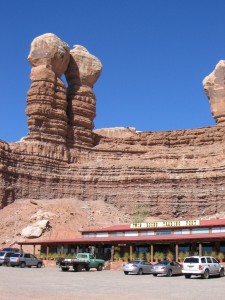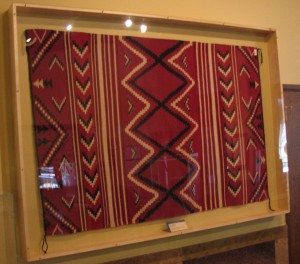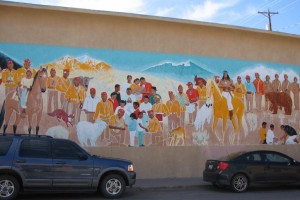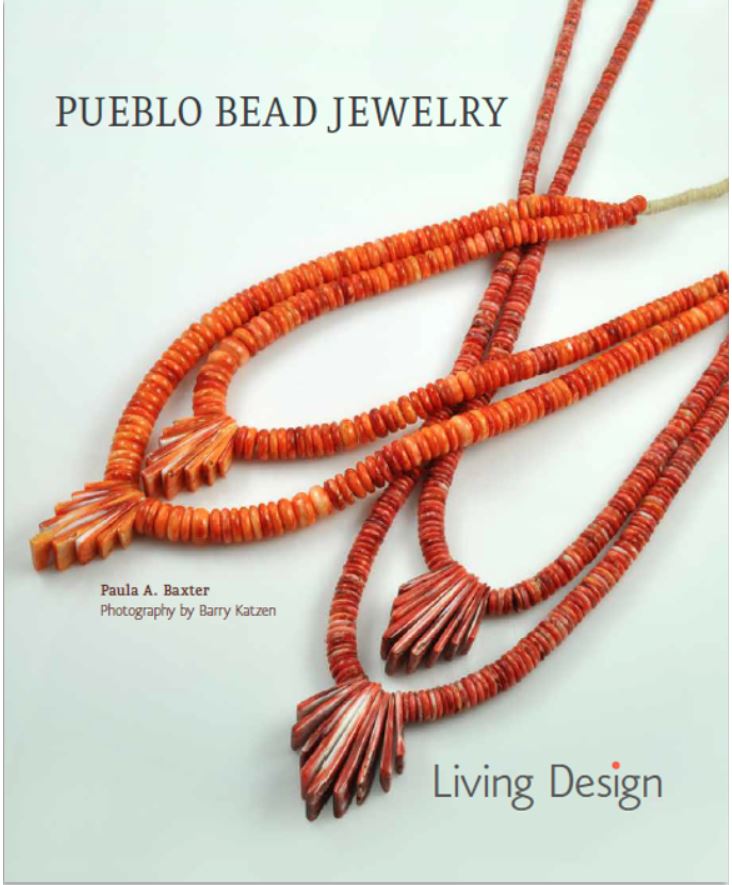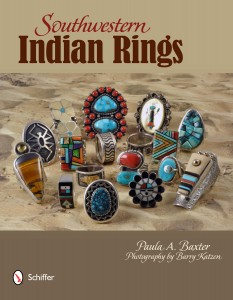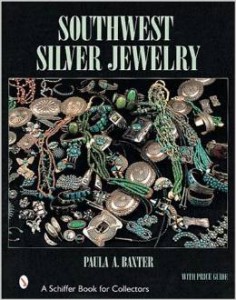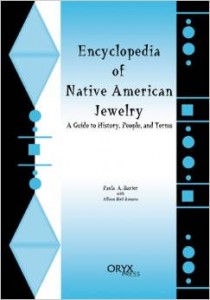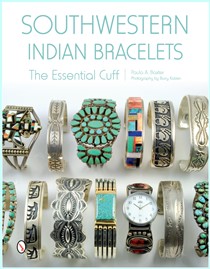As I get off the phone or e-mail with yet another concerned artist, I have to confirm that much consternation is being expressed over a splinter group from SWAIA administration asking for an alternate version of the SWAIA Annual Indian Market. Petitions have been set up and information on this can be found on SWAIA’s Facebook page.
Arts organizations around the U.S. have not done well in the aftermath of the Great Recession of 2008-9. SWAIA and IACA have undergone big changes in personnel and program planning. Indian arts can be considered luxury goods in a harsher economic environment. Many artists, collectors, and dealers are rightfully concerned about how viable the younger generation of collectors and consumers will turn out to be. Most collectors these days appear to belong to the age 40+ group…
Nevertheless, it’s important to look at the reasoning behind asking for a ninety-year-old tradition that has worked so well for so many to be broken or diminished in numbers. What exactly is to be gained by an alternative August Indian Market to be held over overlapping days to the regular Saturday and Sunday weekend, and in an unspecified location that may or may not be near downtown Santa Fe? When you begin to look at the individual artists who favor such a change, certain things become clearer. And I, among others, begin to feel concerned that certain media effects may have inadvertently encouraged divisions within the artistic ranks.
It seems the champions of this splinter show are those who may be considered “high end” in their status as artist. “High end” in this respect means those who can and do charge high prices for quality works which contain valuable materials and designs rendered with expertise and approval from the Indian arts market judging establishment. Many of these artists are at a point in their careers where art galleries are a better venue for their sales than the old-fashioned outdoor booth at SWAIA’s annual show. They may or may not have dealers who are ready to represent them, and plenty of collectors, including international consumers, who rush to purchase their latest creations.
Are these artists going to do better in an Indian arts show which caters to their being part of a specific group with common features?
What has made the Indian arts market so wonderful over the past seventy years is that you could find good work in every price range, especially so with jewelry. Good quality Indian jewelry could be had at high quality costume jewelry prices, and as collectors developed their desires, they spent more if they believed in the artist and his/her aesthetic creativity. If prices show a disconnect between good design and materials, the buyer’s faith becomes eroded. At the same time, most collectors understand that materials costs and scarcity will affect prices, and they may have to pay a little more. Nevertheless, let’s be blunt: most arts, Indian or otherwise, are luxury goods. The makers of mainstream luxury goods like Vuitton and Prada can afford to raise their prices every year because their market will always have deep pockets. Can most Indian artists claim the same about all their customers?
Throughout our trips to the Four Corners area, we’ve arrange the itinerary to include as many trading posts as possible. Through the years, some trading posts have closed and some have been reborn (an example of the latter is the Toadlena Trading Post). Some trading posts are now mostly convenience stores where there are no other places nearby to stop for staples such as bread and milk (such as the Hatch Trading Post, on the way to Hovenweep National Park).
Still other posts are more accurately described as galleries, like Twin Rocks Trading Post in Bluff, Utah. (See Collecting Indian Arts: Phase Two, The Hunt).
And then there are those trading posts, like the one in Teec Nos Pos, that still serve as a meeting place, post office, food store, and a place to trade jewelry, pottery, and weavings.
As I get off the phone or e-mail with yet another concerned artist, I have to confirm that much consternation is being expressed over a splinter group of former SWAIA administors asking for an alternate version of the SWAIA Annual Indian Market.
Arts organizations around the U.S. have not done well in the aftermath of the Great Recession of 2008-9. SWAIA and IACA have undergone big changes in personnel and program planning. Indian arts can be considered luxury goods in a harsher economic environment. Many artists, collectors, and dealers are rightfully concerned about how viable the younger generation of collectors and consumers will turn out to be. Most collectors these days appear to belong to the age 40+ group…
Nevertheless, it’s important to look at the reasoning behind asking for a ninety-year-old tradition that has worked so well for so many to be broken or diminished in numbers. What exactly is to be gained by an alternative August Indian Market to be held over overlapping days to the regular Saturday and Sunday weekend, and in an unspecified location that may or may not be near downtown Santa Fe? When you begin to look at the individual artists who favor such a change, certain things become clearer. And I, among others, begin to feel concerned that certain media effects may have inadvertently encouraged divisions within the artistic ranks.
It seems the champions of this splinter show are those who may be considered “high end” in their status as artist. “High end” in this respect means those who can and do charge high prices for quality works which contain valuable materials and designs rendered with expertise and approval from the Indian arts market judging establishment. Many of these artists are at a point in their careers where art galleries are a better venue for their sales than the old-fashioned outdoor booth at SWAIA’s annual show. They may or may not have dealers who are ready to represent them, and plenty of collectors, including international consumers, who rush to purchase their latest creations. Are these artists going to do better in an Indian arts show which caters to their being part of a specific group with common features?
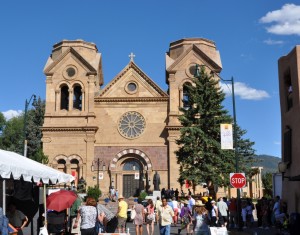 Santa Fe during Indian Market
Santa Fe during Indian Market
This website and blog lay dormant for a period of time in 2013 as I worked intensively on my Southwestern Indian mystery book. This new development has come about because of my enduring interest in writing publishable fiction, after years of nonfiction publication. I also admit that my desire to make this happen was stimulated by friends and colleagues in the Southwest and elsewhere who have repeatedly told me that “we need another good Southwestern mystery series to read.” Even more compelling have been comments from Indian friends who say that they would love to read about realistic and fantasy Indian heroes and villains in a contemporary context. Wish me luck, everybody, as I attempt to make Thirty Pieces of Sage a debut reality.
But for the purposes of this blog, I’d say that certain issues remain critical to consider this year. Pre-Appraisal remains a free service intended to link the neophyte seeking to connect with a reputable dealer and/or appraiser who can help them with determining what their inherited or personal Indian arts pieces are worth in the marketplace.
I will continue to comment on Marketplace topics in the role of impartial critic and writer. I do not engage in the sale of Indian arts and have no vested interests in specific galleries, museums, or dealers. Unfortunately, Indian arts are not always represented genuinely, fairly, or in a manner that accounts for the effects of an active black market inside and outside the United States. I also think the impact of e-Bay™ needs more evaluation…
For my ongoing Blog, I wish to cover some “big picture” issues in the months ahead. This winter was unusual compared to those in recent years. The Southwest had unprecedented wind, water, and severe temperature changes not usually encountered all in one season. A number of chilling articles have popped up in news sources as varied as The New York Times and the Huffington Post. While Native American water rights have always been imperiled, they may be more so now as Southwestern and Western states struggle with droughts that have crippled local livestock, crop, and related food industries.
This website also asks for your contributions. I teach an American art history course at a business college. While my students come from diverse backgrounds, they know woefully little about Native Americans, who are featured in the course along with the contributions of African-American and Hispanic artists. They learn and sympathize with the painful past of our American Indians but I am more interested in telling them about the triumphs and the needs of the future for our Native peoples. In other words, can we move beyond cowboys and teepees?
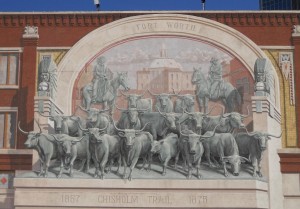 Mural in Fort Worth, TX, showing the end of the Chisholm Trail.
Mural in Fort Worth, TX, showing the end of the Chisholm Trail.
 Cement Teepee in Globe, AZ.
Cement Teepee in Globe, AZ.
That’s a problem right there. Indian artists have endured too many years of competing with schlock souvenir goods that too many people see and think are legitimate. The years of discount sales, ones that still go on today at selected locations, have eroded buyer trust. When you bring those people who collect Indian arts but aren’t personally wealthy (like yours truly) to Indian Market, they aren’t looking for a bargain, but they are looking for something they can spend their money on with pride and pleasure. Why should those who can afford high end arts be the only ones who can count on getting value for their money? Collectors are better educated than they used to be.
(Part 3 of a series)
 Santa Fe Cathedral during Indian Market
Santa Fe Cathedral during Indian Market
Those who want to buy have had their enthusiasm strangled on two fronts:
- First, there are still too many eyewitness accounts of suspect materials appearing in jewelry; SWAIA has strict standards about this, and while I believe they are upholding them as best they can, it’s analogous to the situation where cops can’t catch and ticket all the texting/cell chatting drivers.
- Second, many artists are pricing their works too high. Yes, materials costs have gone up, but in an era where money is an issue again, only the very high-end artists can maintain their prices.
Maybe it’s time someone out in the Southwest organized a town hall or forum that addresses the realities of pricing. I worry that too many people think they entitled to getting higher prices right away, when time has shown that artist reputations are earned and not created overnight. Superstars like Cody Sanderson and Pat Pruitt put in a lot of time selling at reasonable prices to build a reputation for good quality designs.
(Part 2 of a series)
